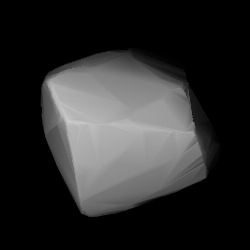 Modelled shape of Bononia from its
lightcurve | |
| Discovery | |
|---|---|
| Discovered by | Auguste Charlois |
| Discovery date | 11 March 1893 |
| Designations | |
| (361) Bononia | |
| Pronunciation | /bəˈnoʊniə/ [1] |
Named after | Bologna (Bonōnia) |
| 1893 P | |
| Main belt ( Hilda) | |
| Adjectives | Bononian |
| Orbital characteristics [2] | |
| Epoch 31 July 2016 ( JD 2457600.5) | |
| Uncertainty parameter 0 | |
| Observation arc | 114.83 yr (41940 d) |
| Aphelion | 4.80719 AU (719.145 Gm) |
| Perihelion | 3.11281 AU (465.670 Gm) |
| 3.96000 AU (592.408 Gm) | |
| Eccentricity | 0.21394 |
| 7.88 yr (2878.3 d) | |
| 329.195 ° | |
| 0° 7m 30.259s / day | |
| Inclination | 12.6264° |
| 18.8738° | |
| 68.3637° | |
| Physical characteristics | |
| Dimensions | 141.72±6.9 km |
| 13.83 h (0.576 d) | |
| 0.0453±0.005 | |
| D | |
| 8.22 | |
361 Bononia /bəˈnoʊniə/ is a very large, resonant Hilda asteroid located in the outermost region of the asteroid belt. [2] It is classified as a D-type asteroid and is probably composed of organic rich silicates, carbon and anhydrous silicates. It was discovered by Auguste Charlois on 11 March 1893, in Nice, and assigned the prov. designations A893 EF and 1893 P.
- ^ "Bononia". Merriam-Webster.com Dictionary.
- ^ a b "361 Bononia (1893 P)". JPL Small-Body Database. NASA/ Jet Propulsion Laboratory. Retrieved 11 May 2016.
- 361 Bononia at AstDyS-2, Asteroids—Dynamic Site
- 361 Bononia at the JPL Small-Body Database
 Modelled shape of Bononia from its
lightcurve | |
| Discovery | |
|---|---|
| Discovered by | Auguste Charlois |
| Discovery date | 11 March 1893 |
| Designations | |
| (361) Bononia | |
| Pronunciation | /bəˈnoʊniə/ [1] |
Named after | Bologna (Bonōnia) |
| 1893 P | |
| Main belt ( Hilda) | |
| Adjectives | Bononian |
| Orbital characteristics [2] | |
| Epoch 31 July 2016 ( JD 2457600.5) | |
| Uncertainty parameter 0 | |
| Observation arc | 114.83 yr (41940 d) |
| Aphelion | 4.80719 AU (719.145 Gm) |
| Perihelion | 3.11281 AU (465.670 Gm) |
| 3.96000 AU (592.408 Gm) | |
| Eccentricity | 0.21394 |
| 7.88 yr (2878.3 d) | |
| 329.195 ° | |
| 0° 7m 30.259s / day | |
| Inclination | 12.6264° |
| 18.8738° | |
| 68.3637° | |
| Physical characteristics | |
| Dimensions | 141.72±6.9 km |
| 13.83 h (0.576 d) | |
| 0.0453±0.005 | |
| D | |
| 8.22 | |
361 Bononia /bəˈnoʊniə/ is a very large, resonant Hilda asteroid located in the outermost region of the asteroid belt. [2] It is classified as a D-type asteroid and is probably composed of organic rich silicates, carbon and anhydrous silicates. It was discovered by Auguste Charlois on 11 March 1893, in Nice, and assigned the prov. designations A893 EF and 1893 P.
- ^ "Bononia". Merriam-Webster.com Dictionary.
- ^ a b "361 Bononia (1893 P)". JPL Small-Body Database. NASA/ Jet Propulsion Laboratory. Retrieved 11 May 2016.
- 361 Bononia at AstDyS-2, Asteroids—Dynamic Site
- 361 Bononia at the JPL Small-Body Database